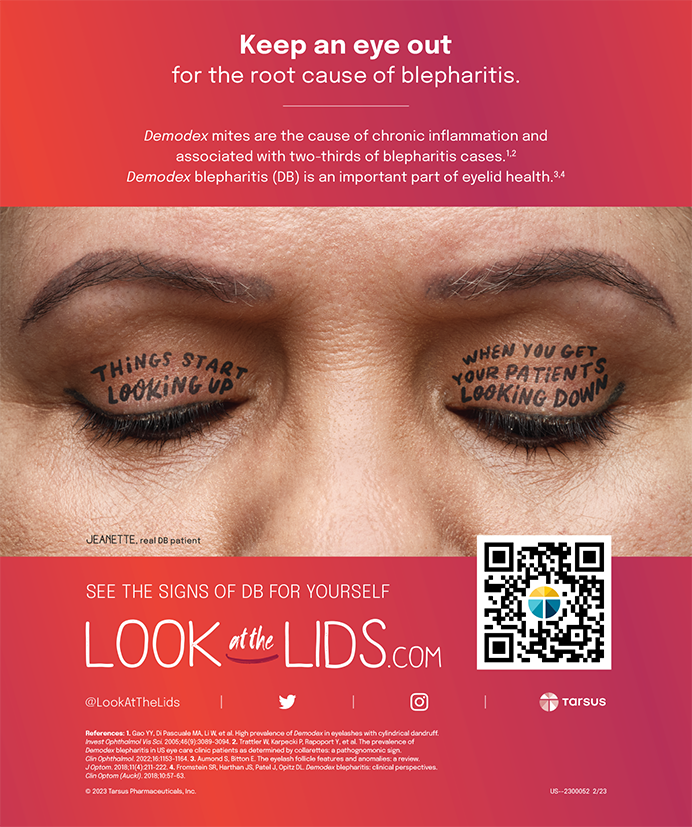
Cataract surgery is the most frequently performed elective procedure globally. In the United Kingdom alone, an estimated 452,000 cataract surgeries were carried out from 2018 to 2019.1 The latest technological advances allow experienced surgeons to remove a cataract safely and patients to recover from surgery in a relatively short time.
Cataract surgery is a life-changing procedure for patients. The moment they step through the door to your clinic, you are given a unique opportunity to make a difference in their lives. How you use the opportunity defines the lifelong doctor-patient relationship (see Five Tips for Building Lifelong Relationships).
Five Tips for Building Lifelong Relationships
1. Offer trust and transparency to patients
2. Maintain an uncompromising approach to patient care
3. Be a good doctor, not just a good eye doctor
4. Do not underestimate the power of the written word; excellent communication with your colleagues, optometrists, and general practitioners is crucial
5. Take care of your team and yourself; invest in yourself to become your own brand
LOOK AT THE BIG PICTURE
I offer patients integrity, trust, transparency, and warmth. In the modern era of subspecialized medicine, it is tempting to focus on the cataract. This mindset can affect the quality of care that you provide to patients. Ocular conditions such as lid margin disease, dry eye disease (DED), and glaucoma as well as systemic conditions such as diabetes can increase the risk of complications if not detected or managed preoperatively. These and other conditions can also determine the choice of treatment. An individualized and holistic approach is therefore required to ensure the best outcomes for each patient.
An increasing number of cataract surgery patients present with DED. Known risk factors include age, sex, lifestyle, general health, and diet.2 Recently, a phenomenon known as mask-associated dry eye has been associated with an increased prevalence of DED. Patients who present for cataract surgery should undergo diagnostic testing and, if DED is present, therapeutic treatment to address the issue. From providing patients with a lid management brochure and advice on nutritional supplements that include omega-3 fatty acids to the use of intense pulsed light treatment for the management of meibomian gland dysfunction, I aim to achieve a comprehensive yet targeted approach to managing this chronic eye condition. This can also have a positive impact on patients’ outcomes and quality of life.
MAKE USE OF POWERFUL MESSENGERS
The main outcome of cataract surgery is restoration of vision. Its effects, however, are much more profound and include improved mood and a reduced risk of falls and morbidity.3,4 Additionally, the latest advances in lens technology increase patients’ opportunities to achieve full spectacle independence.
It is advisable to encourage patients’ family, friends, and caregivers to be active participants in the journey. Their involvement can reinforce proper expectations for the surgery and improve postoperative compliance. These individuals also witness, directly or indirectly, the significant impact your care has on their loved one’s life. The trust you develop with these powerful messengers can go a long way to ensuring the continuity of care.
BE A GOOD DOCTOR
As physicians, it is crucial we recognize the ocular signs of systemic disease when assessing cataract patients. Temporal headache and blurred vision in an 80-year-old woman, for example, may signal giant cell arteritis and should prompt a more targeted examination and an emergency referral if suspected. There is nothing more rewarding than a letter of acknowledgment from your patient’s physician that your actions helped to save a patient’s life.
Establish a working relationship with colleagues from other ophthalmic subspecialties. Whether you need an opinion about an epiretinal membrane, macular degeneration, or advanced glaucoma, working with colleagues who share your values and uncompromising approach to patient care is essential.
COMMUNICATION IS KEY
Patients typically see their surgeon as the main authority on their eye care needs. We, however, are only one part of a larger community that includes our clinical staff, allied health care professionals, and primary care physicians. It is essential to recognize the significant contributions these professionals make to the cataract surgery patient’s lifecycle and have a mutually respectful and efficient relationship with them.
A mutually beneficial relationship with all members of the eye care community can be achieved with good communication. The use of letters, online portals, and telephone calls to both optometrists and doctors facilitates fast, efficient, and secure communication. Asking patients for the source of their referral establishes the patients’ gateway to your practice. Communicating with the referral source can engender mutual trust.
At the end of the patient assessment, I make sure the outcome report is professionally written, well structured, easy to read, and correctly addressed before it is forwarded to all involved parties. The optometrists and general practitioners who are comanaging the patient appreciate my efforts. This improves the continuity of care for my patients.
BE YOUR ‘BRAND’
American entrepreneur Jim Rohn is credited with saying the following: “It’s important to learn from your mistakes, but it is better to learn from other people’s mistakes, and it is best to learn from other people’s successes. It accelerates your own success.”
I cannot forget the words of wisdom shared with me years ago by my mentor and legendary Irish ophthalmologist Michael O’Keefe, FRCS, about the importance of the three As—affability, ability, and availability in patient care. The foundation of patient care is built on the quality of the relationship you develop with your patients.
Fouad Hajjar, MD, a highly respected ophthalmologist in Catalonia, Spain, shared the following wisdom with me: It is how you make your patients feel that matters most. This simple advice is surprisingly challenging to follow, but the power to influence how our patients feel by listening to them, respecting them, and keeping them safe provides the groundwork for a mutually beneficial relationship. It is therefore our responsibility to nurture and maintain the feelings of trust and transparency with our patients for many years to come.
Sheraz M. Daya, MD, FACP, FACS, FRCS(Ed), FRCOphth, one of my most influential mentors, shared with me that we should all become our own brands. This can be accomplished by staying true to our values and principles, maintaining an uncompromising approach to patient care, taking care of our team, and investing in ourselves to gradually build our reputation. This influences the relationships we have with colleagues and patients and defines our success.
1. Ferris JD, Donachie PH, Johnston RL, Barnes B, Olaitan M, Sparrow JM. Royal College of Ophthalmologists’ National Ophthalmology Database study of cataract surgery: report 6. The impact of EyeSi virtual reality training on complications rates of cataract surgery performed by first and second year trainees. Br J Ophthalmol. 2020;104(3):324-329.
2. Stapleton F, Alves M, Bunya VY, et al. TFOS DEWS II epidemiology report. Ocul Surf. 2017;15(3):334-365.
3. Chia EM, Wang JJ, Rochtchina E, Smith W, Cumming RR, Mitchell P. Impact of bilateral visual impairment on health-related quality of life: the Blue Mountains Eye Study. Invest Ophthalmol Vis Sci. 2004;45(1):71-76.
4. Harwood RH, Foss AJ, Osborn F, Gregson RM, Zaman A, Masud T. Falls and health status in elderly women following first eye cataract surgery: a randomised controlled trial. Br J Ophthalmol. 2005;89(1):53-59.




